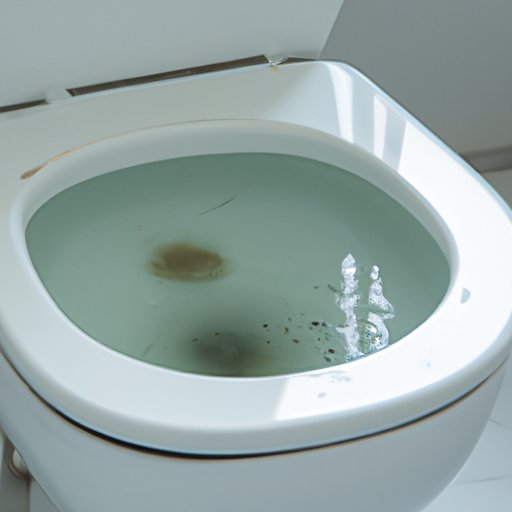Introduction
A dirty toilet tank can be a breeding ground for bacteria and germs, and no one wants that in their home. Cleaning your toilet tank may seem like a daunting task, but it doesn’t have to be. In this article, we will provide you with a step-by-step guide, natural cleaning solutions, prevention tips, best practices for hygiene, troubleshooting, and expert insights to help you get the job done efficiently and effectively.
Step-by-step Guide
The following steps will guide you through how to clean your toilet tank:
1. Turn off the water supply – Before cleaning the tank, turn off the water supply to prevent any water from entering the tank.
2. Empty the tank – Next, empty the tank of any remaining water. You can do this by flushing the toilet or using a bucket to scoop out the water.
3. Scrub away dirt, grime, and stains using a good quality scrub brush – Using a good quality scrub brush, scrub away any dirt, grime, and stains in the tank. You can use a toilet bowl cleaner or a natural solution we will discuss later in this article.
4. Clean the flapper and other components – Clean the flapper and other components in the tank. These may include the flush valve, fill valve, and overflow pipe. Use a brush or cloth to remove any dirt or buildup.
5. Reassemble the tank and turn the water supply back on – Once you have cleaned everything, reassemble the tank and turn the water supply back on. Test the flush to ensure everything is working correctly.
Natural Cleaning Solutions
Natural cleaning solutions are beneficial for several reasons. They are inexpensive, eco-friendly, and safe to use around children and pets. Here are three natural solutions you can use to clean your toilet tank:
1. Vinegar – White vinegar is a natural disinfectant that can help remove stains and kill germs. Mix one cup of vinegar with one cup of water and pour it into the tank. Let it sit for 30 minutes and then scrub with a brush. Rinse with water.
2. Baking soda – Baking soda is an excellent natural cleaner and deodorizer. Mix half a cup of baking soda with one cup of water and pour it into the tank. Let it sit for 30 minutes and then scrub with a brush. Rinse with water.
3. Lemon juice – Lemon juice is not only a natural disinfectant but also leaves your toilet with a fresh scent. Mix half a cup of lemon juice with one cup of water and pour it into the tank. Let it sit for 30 minutes and then scrub with a brush. Rinse with water. For a more effective solution, add a few drops of essential oil.
Tools & Equipment
When cleaning your toilet tank, you will need a few essential tools and equipment. These include:
1. Good quality scrub brush – Look for a brush with firm bristles that can remove stubborn stains but won’t scratch the tank’s surface.
2. Gloves – It’s essential to wear gloves when cleaning your toilet tank to prevent direct contact with germs and bacteria.
3. Bucket – A bucket is handy for scooping out any remaining water in the tank.
Prevention Tips
The best way to keep your toilet tank clean is to prevent it from getting dirty in the first place. Here are some tips on how to do that:
1. Regular cleaning – Regularly cleaning your toilet tank will help prevent stains and buildup. Aim to clean it at least once a month.
2. Use a toilet bowl cleaner correctly – Follow the instructions on your toilet bowl cleaner and avoid overusing it. Leaving the cleaner in the bowl for too long can damage the tank’s components.
3. Avoid putting certain items in the toilet bowl – Avoid putting items such as cotton balls, Q-tips, and feminine hygiene products in the toilet bowl. These can clog your pipes and damage your toilet tank.
Best Practices for Hygiene
It’s essential to maintain good hygiene when cleaning your toilet tank. Here are some best practices to follow:
1. Use protective gear – Wear gloves and a facemask when cleaning your toilet tank to protect yourself from germs and bacteria.
2. Ensure proper ventilation – Open a window or turn on the fan while cleaning your toilet tank to ensure proper ventilation.
Troubleshooting
Despite your best efforts, you may encounter some problems when cleaning your toilet tank. Here are some common issues and how to solve them:
1. Leaks or cracks – If you notice any leaks or cracks in your tank, you may need to replace it or call a professional plumber.
2. Buildup in pipes – Sometimes buildup can occur in your pipes, causing your toilet to flush slowly. You may need to use a drain cleaner or call a professional plumber to fix this issue.
Expert Insights
“Cleaning your toilet tank regularly is an essential part of maintaining a healthy home. When using natural cleaning solutions, be sure to follow the instructions carefully and avoid mixing different solutions. If you encounter any issues, don’t hesitate to call a professional plumber for help.” – Jim Smith, Plumbing Expert.
Conclusion
Cleaning your toilet tank may seem like a daunting task, but it’s essential for maintaining a healthy home. With the step-by-step guide, natural cleaning solutions, prevention tips, best practices for hygiene, troubleshooting, and expert insights provided in this article, you can clean your toilet tank quickly and efficiently. Remember to maintain regular cleaning and follow proper hygiene practices to keep your toilet tank in tip-top condition.
